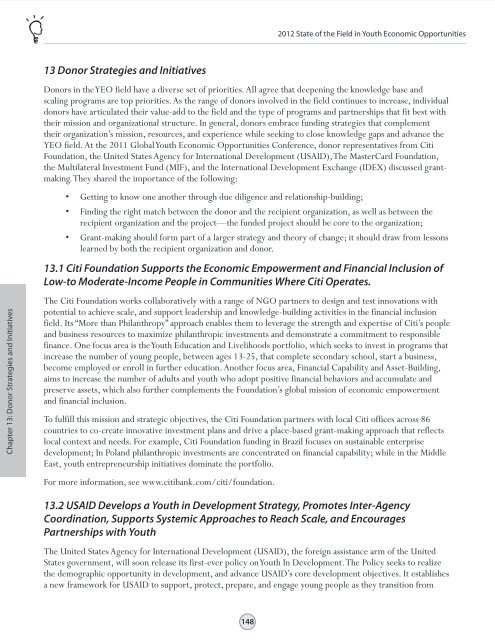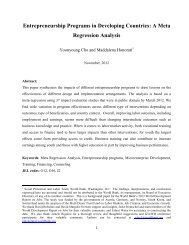STATE OF THE FIELD IN YOUTH ECONOMIC OPPORTUNITIES
STATE OF THE FIELD IN YOUTH ECONOMIC OPPORTUNITIES
STATE OF THE FIELD IN YOUTH ECONOMIC OPPORTUNITIES
Create successful ePaper yourself
Turn your PDF publications into a flip-book with our unique Google optimized e-Paper software.
Table of Contents<br />
Chapter 9<br />
Chapter 1 Chapter 2 Chapter 3 Chapter 4 Chapter 5 Chapter 6 Chapter 7 Chapter 8<br />
Chapter 10 Chapter 11 Chapter 12 Chapter 13 Chapter 14 Chapter 15 Annexes<br />
2012 State of the Field in Youth Economic Opportunities<br />
13 Donor Strategies and Initiatives<br />
Donors in the YEO field have a diverse set of priorities. All agree that deepening the knowledge base and<br />
scaling programs are top priorities. As the range of donors involved in the field continues to increase, individual<br />
donors have articulated their value-add to the field and the type of programs and partnerships that fit best with<br />
their mission and organizational structure. In general, donors embrace funding strategies that complement<br />
their organization’s mission, resources, and experience while seeking to close knowledge gaps and advance the<br />
YEO field. At the 2011 Global Youth Economic Opportunities Conference, donor representatives from Citi<br />
Foundation, the United States Agency for International Development (USAID), The MasterCard Foundation,<br />
the Multilateral Investment Fund (MIF), and the International Development Exchange (IDEX) discussed grantmaking.<br />
They shared the importance of the following:<br />
• Getting to know one another through due diligence and relationship-building;<br />
• Finding the right match between the donor and the recipient organization, as well as between the<br />
recipient organization and the project—the funded project should be core to the organization;<br />
• Grant-making should form part of a larger strategy and theory of change; it should draw from lessons<br />
learned by both the recipient organization and donor.<br />
13.1 Citi Foundation Supports the Economic Empowerment and Financial Inclusion of<br />
Low-to Moderate-Income People in Communities Where Citi Operates.<br />
Chapter 13: Donor Strategies and Initiatives<br />
The Citi Foundation works collaboratively with a range of NGO partners to design and test innovations with<br />
potential to achieve scale, and support leadership and knowledge-building activities in the financial inclusion<br />
field. Its “More than Philanthropy” approach enables them to leverage the strength and expertise of Citi’s people<br />
and business resources to maximize philanthropic investments and demonstrate a commitment to responsible<br />
finance. One focus area is the Youth Education and Livelihoods portfolio, which seeks to invest in programs that<br />
increase the number of young people, between ages 13-25, that complete secondary school, start a business,<br />
become employed or enroll in further education. Another focus area, Financial Capability and Asset-Building,<br />
aims to increase the number of adults and youth who adopt positive financial behaviors and accumulate and<br />
preserve assets, which also further complements the Foundation’s global mission of economic empowerment<br />
and financial inclusion.<br />
To fulfill this mission and strategic objectives, the Citi Foundation partners with local Citi offices across 86<br />
countries to co-create innovative investment plans and drive a place-based grant-making approach that reflects<br />
local context and needs. For example, Citi Foundation funding in Brazil focuses on sustainable enterprise<br />
development; In Poland philanthropic investments are concentrated on financial capability; while in the Middle<br />
East, youth entrepreneurship initiatives dominate the portfolio.<br />
For more information, see www.citibank.com/citi/foundation.<br />
13.2 USAID Develops a Youth in Development Strategy, Promotes Inter-Agency<br />
Coordination, Supports Systemic Approaches to Reach Scale, and Encourages<br />
Partnerships with Youth<br />
The United States Agency for International Development (USAID), the foreign assistance arm of the United<br />
States government, will soon release its first-ever policy on Youth In Development. The Policy seeks to realize<br />
the demographic opportunity in development, and advance USAID’s core development objectives. It establishes<br />
a new framework for USAID to support, protect, prepare, and engage young people as they transition from<br />
148

















